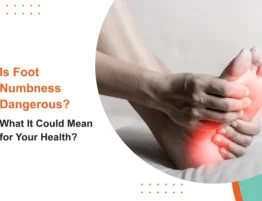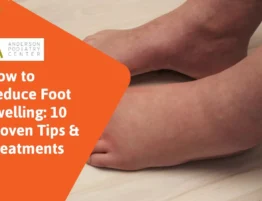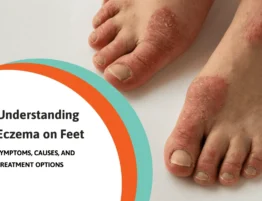
How to deal with foot and ankle surgeries?
When it comes to sports injuries, your foot and ankle are areas at highest risk of injury. Within sports themselves, injuries are common. A foot or ankle injury could result from the repetitive stress of running on hard surfaces, or from the stress of side-to-side activities in sports such as tennis or soccer. Other injuries may not be from overuse, but from trauma such as an ankle sprain. Commonly seen foot and ankle surgeries are listed below:
- Plantar Fasciitis
- Achilles Tendonitis
- Peroneal or Posterior Tibial Tendonitis
- Neuromas
- Stress Fractures
- Ankle Sprain
- Ankle Fracture
Below, read through the descriptions of the most common foot and ankle overuse injuries.
Plantar Fasciitis: This will cause pain on the bottom of the heel. It usually hurts most in the morning when you take your first step out of bed. The fascia is a very strong binding tissue that originates in the ball of the foot and connects to the bottom of the heel . As we get older, it tends to lose flexibility. A common attempt for relief is stretching of the fascia and the Achilles which is attached to the large calf muscle called the gastrocnemius muscle. We often use custom orthotics precisely designed for your feet to reduce pulling of the fascia from the heel. Regenerative medicine has also worked very well to eliminate the pain by repairing the fascial tissue which has become damaged.
View our full Testimonials here.
Achilles Tendonitis: Here, the pain can be located where the Achilles attaches to the heel. Sometimes referred to as a Haglund’s deformity, this is when additional bone may be created from the tendon constantly rubbing against the heel. The pain may also be along the tendon above where it attaches to the heel. The tendon will also become swollen as time goes on. The more chronic the condition, the more painful the condition. In early stages, rest, icing, and stretching may help. Custom made inserts and orthotics are very successful in treating Achilles tendonitis as they help reduce tension on the tendon by reducing rotation of the heel bone where the tendon attaches as you walk or run. Regenerative medicine has also been a game changer in eliminating this sometimes-persistent problem.
Peroneal and Posterior Tibial Tendonitis: The peroneal tendons (peroneus longus and peroneus brevis) run along the outside to the foot and ankle. However, the tendon that runs on the inside of the ankle and the foot is the posterior tibial tendon. These tendons function to help stabilize the foot from moving side to side. I refer to them as stirrup tendons. Pain will present along the inside of the arch by the ankle or on the outside of the foot around the ankle joint. Treatment may involve rest, and icing in early stages. However, more foot support is often the best treatment. The podiatrist will often recommend custom inserts or orthotics to reduce the stress placed on these tendons, as the support of these inserts will counter this. This tendon can also develop tears, which can require surgical repair. However, the advent of regenerative medicine has drastically reduced the need for surgery.
Neuromas: The pain with neuromas typically present as a swollen nerve in the ball of the foot, between the second and third toe, or between the third and fourth toes. Often you’ll feel like your sock is wrinkled because of the swollen feeling. This is caused by the transverse metatarsal ligament that runs along the bottom of the foot compressing on the nerve. Support with orthotics and cortisone injections are frequently used. We will also use lasers, but at times, conservative measures fail. If so, there is surgery to release and decompress the ligament that is rubbing the nerve may be needed.
Trauma Injuries: These are injuries that if you suspect you have need to be seen by a professional
Stress Fractures: These can be caused by overuse. The constant repetition from the activity will gradually stress the bone. These fractures rarely occur in the bones that are part of the ankle joint area or rearfoot. However, they are frequent in the long metatarsal bones. These are the bones that extend from the midfoot area down to the ball of the foot. They are the longest bones in the foot and subject to a lot of stress. Pain will often present along one of these bones and will be accompanied by swelling.
Ankle Sprains: These are very common and usually the pain will be on the outside of the ankle. The injury can stretch or tear the ligaments that support your ankle, so sometimes immobilization in a cam boot may be necessary to access in healing
Ankle Fractures: In certain situations, it may be obvious that you broke your ankle. But in other situations, it could be confused with a bad ankle sprain. Again, it’s important not to assume you just sprained your ankle.
If you’re suspicious of these, a professional opinion from a podiatrist should be considered sooner rather than later. And finally, to counter what you may have heard, you can walk on a broken bone! If you need a foot doctor fort collins, make an appointment today!
Our Locations
Fort Collins
1355 Riverside Avenue,
Suite C, Fort Collins, CO 80524
(MAP)
(970) 484-4620
HOURS:
Mon: 8:00 am – 5:00 pm
Tue: 8:00 am – 5:00 pm
Wed-: 8:00 am – 5:00 pm
Thus: 8:00 am – 5:00 pm
Fri: 8:00 am – 4:00 pm
Broomfield
3303 West 144th Ave #207
Broomfield, CO 80023
(MAP)
(720) 259-5053
HOURS:
Mon: 8:00 am – 5:00 pm
Tue: 8:00 am – 5:00 pm
Wed: 8:00 am – 5:00 pm
Thurs: 8:00 am – 5:00 pm









Write a comment: